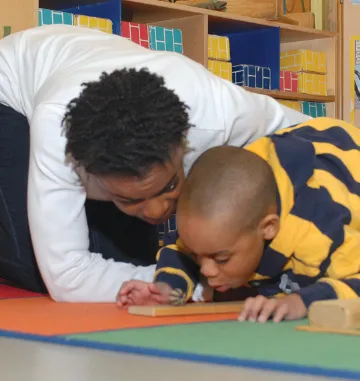![]()
STEP THREE: EXTEND LEARNING
As you nurture your relationship, stretch the child’s knowledge and understanding
STEP THREE: EXTEND LEARNING
| As you read this chapter, pause to reflect on what you’re learning. How could you use its ideas and strategies in your setting? |
STEP THREE: EXTEND LEARNING
Here you are together — for a minute or maybe five. You’ve made a connection, and as you sustain that connection, deepening your relationship with the child, you can make the interaction into a Powerful Interaction by simultaneously extending the child’s learning just a bit. When children have a strong, positive relationship with you, they feel safe, competent, and able to move out into the world, or “take distance” to explore, experiment, and learn (Sigel 1993). The combination of intentionally building your relationship and extending a child’s learning is the essence of a Powerful Interaction.
In Step Three of a Powerful Interaction, you not only model for the child how to learn, you also stretch the child’s thinking and knowledge — all in a way that is just right for that child. No matter what you teach, how you interact as you do it influences how well children learn it. Children who have positive relationships with their teachers also are more engaged in learning. When they feel the comfort and security that comes from a trusting relationship, children are more willing to explore, ask questions, solve problems, try new challenges, and express their thinking (O’Connor & McCartney 2007).
You met the teachers in the following examples in the chapter Step Two: Connect. Now, let’s look at how they use their relationships with the children as the foundation for extending each child’s learning:
As Ms. Zora joins 2-year-old Dennis at the sandbox, she initiates a connection with him by giving him a warm smile. She says, “Hi, Dennis! I’ve been watching you digging this great big hole. Your muscles are getting such a workout!” Dennis looks up at Ms. Zora with a huge grin on his face. Opening his eyes wide, he says to her, “Big hole!”… Ms. Zora models curiosity and encourages him to make a prediction about size: “I wonder what could fit in that hole. What do you think might fit in that hole, Dennis?” She waits for Dennis to respond. After a moment, she asks, “Should we try this ball? Will it fit or will it be too big? What do you think, Dennis?” Dennis takes the ball from Ms. Zora and puts it in the hole. It fits and he laughs!
Three-year-old Celia has dumped a basket of smooth stones on the rug and is putting them back in one by one, saying a number in random order each time. Mr. Yosef settles in next to her on the floor and, leaning in toward her just a little bit, comments: “I heard all these numbers and wondered who was practicing their counting. It’s Celia!” She says, “Wanna watch me?” … She counts to 5, randomly pointing to the stones. To extend her learning Mr. Yosef decides to help her move from random counting to one-to-one object counting. “Shall we count them together?” Celia nods her head. Mr. Yosef models how to count objects. He says, “Let’s get our fingers ready to point. We’ll point to each one as we say the number. Ready?” Celia sticks out her finger and together they point and count.
Slowly and methodically, 4-year-old Khalid looks through every book on the bookshelf. Mr. Hall watches him and decides to initiate a Powerful Interaction. He silently kneels beside him and joins in his search for a good book. After a few seconds, Khalid takes one of the books off the shelf, holds it in his lap, and begins turning the pages slowly. Sitting quietly beside Khalid, Mr. Hall watches to see the child’s body settle and senses that he is getting comfortable with the teacher’s presence before beginning to talk about the book. … To extend his learning, Mr. Hall says, “I’m curious about the book you’re looking at, Khalid. The pictures of the shoes look very interesting. Can we look at it together?” Khalid turns to look at him, slides the book over so that it is between them, points to a pair of cowboy boots, and says, “These are my favorite.” A back-and-forth conversation about what Khalid is reading and noticing in the book begins. Mr. Hall makes sure to bring out key concepts about print and interesting vocabulary during their conversation.
What Does It Mean to “Extend Learning”?
A Powerful Interaction is a teachable moment with a child — a chance for skillful and deliberate teaching. During a Powerful Interaction, you have a window into the child’s experience and thinking, because in this moment, your attention is focused on the child — her actions and/or language.
In this rich teaching moment, you stay present, so that you can intentionally make sensitive and responsive decisions about the individual child’s learning needs. Just as you need to be alert to how the child reacts each time you invite a connection, the teaching strategy you choose in Step Three may need to shift as children learn and develop, each in his or her own unique way.
Three questions will help you make effective decisions about how to extend that child’s learning. We examine each question separately so you can understand and think about each one carefully.
“The greatest opportunity for learning lies in moments of teacher-child interaction, when the teacher crafts learning experiences that stretch children just beyond their current skill level.”
— Munro 2008, 47
1. What’s the right content to teach in this moment? Being present and focused on the child (Step One: Be Present) and observing what is interesting and significant about what the child is doing (Step Two: Connect) help you know what the child needs from you in order to learn in this moment. Is the child talking? If so, you might decide to introduce a new vocabulary word. Perhaps the child is working on cause-and-effect thinking. If so, you might ask, “Why do you think that happened?” Maybe the child is counting or measuring, and you could focus the interaction on math content. Or the child might be trying to sound out a word, and you could decide to help with the sound a certain letter makes.
Deidre, age 4, uses red playdough and cookie cutters to make a series of shapes. She lines them up in a row from left to right. Rhonda, her teacher, watches and recognizes that this is a good moment to extend Deidre’s understanding of geometry (because of the shapes) and spatial thinking (because of how she’s carefully placing them in a straight row on the table).
2. What’s the next step in this child’s learning? Once you decide on the content area to focus on, you can think about the next small learning step the child is ready to take: What does she already know? What can she already do? By drawing on your knowledge of the child, as well as on your knowledge of the typical sequence of learning steps in that content area, you can decide how to extend the child’s learning just a bit in that moment. Your goal is to keep the child engaged and learning — but at the same time, feelin...





